Pesticide Exposure in Fruit-Growers: Comparing Levels and Determinants Assessed under Usual Conditions of Work (CANEPA Study) with Those Predicted by Registration Process (Agricultural Operator Exposure Model)
Abstract
:1. Introduction
2. Materials and Methods
2.1. Study Population
2.2. Observations of Farm Operators and Sample Collection
2.3. Use of the Agricultural Operator Exposure Model (AOEM)
2.4. Statistical Analysis
3. Results
3.1. Data Used for Calculation
3.2. Example of Observation 1
3.3. Comparison of Measured and Predicted Values
3.3.1. Measured Exposure
3.3.2. Calculated Exposure
3.4. Relationship between Measured and Calculated Exposures
4. Discussion
4.1. Main Results
4.2. Limitations and Strengths
4.3. External Validity
5. Conclusions
Author Contributions
Funding
Institutional Review Board Statement
Informed Consent Statement
Data Availability Statement
Acknowledgments
Conflicts of Interest
Appendix A
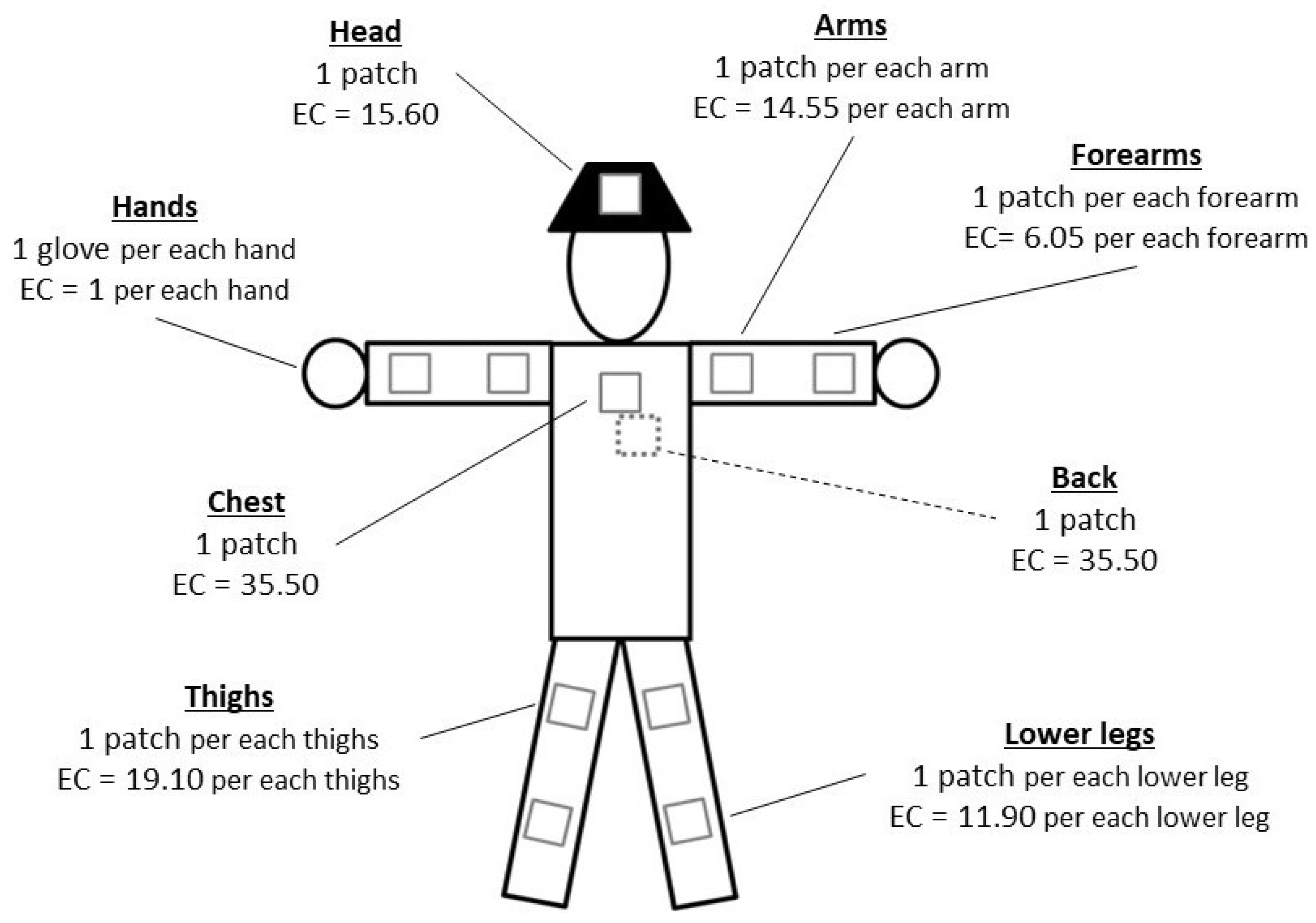
Appendix B
| Mixing/Loading | Application | |||
|---|---|---|---|---|
| Intercept factor (fixed value) | WG and SC form | Body | 3.09 | 3.47 |
| Hands | 3.12 | 3.12 | ||
| Head | −0.98 | 1.17 | ||
| Protected body | 1.27 | 1.83 | ||
| Protected hands | 1.22 | 1.55 | ||
| Amount applied factor (fixed value) | WG and SC form | Body | 0.70 | 1 |
| Hands | 0.77 | 0.89 | ||
| Head | 1 | 1 | ||
| Protected body | 0.89 | 1 | ||
| Protected hands | 0.65 | 1 | ||
| Scenario factor (fixed value) | WG form | Body | 0 | 0.48 |
| Hands | 0 | 0.28 | ||
| Head | 0 | 1.89 | ||
| Protected body | 0 | 0.23 | ||
| Protected hands | 0 | 0 | ||
| SC form | Body | 0.46 | 0.48 | |
| Hands | 0.57 | 0.28 | ||
| Head | 0.90 | 1.89 | ||
| Protected body | 0.11 | 0.23 | ||
| Protected hands | 0.32 | 0 | ||
Appendix C. Example of AOEM Worksheet

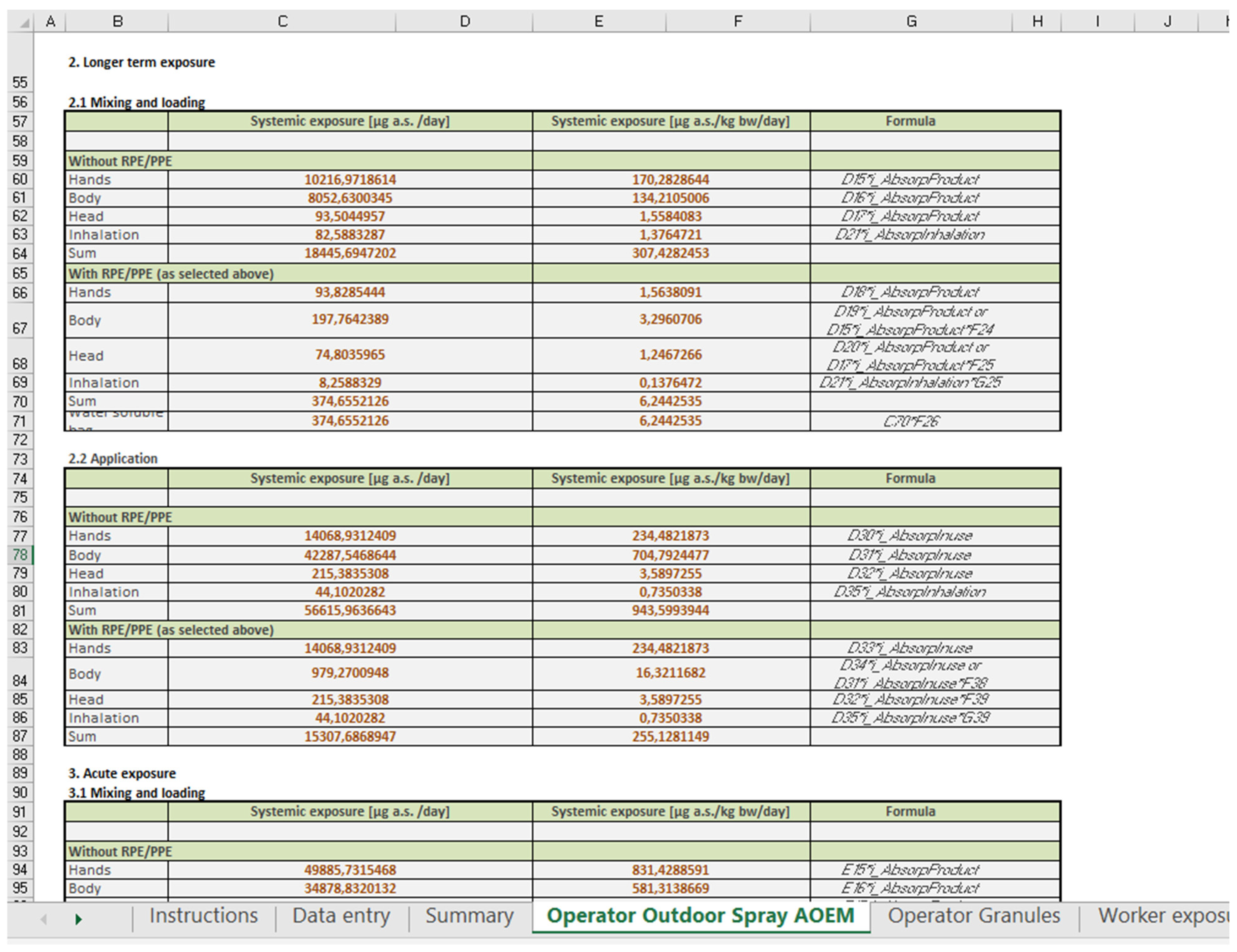
Appendix D. Sensitivity Analysis
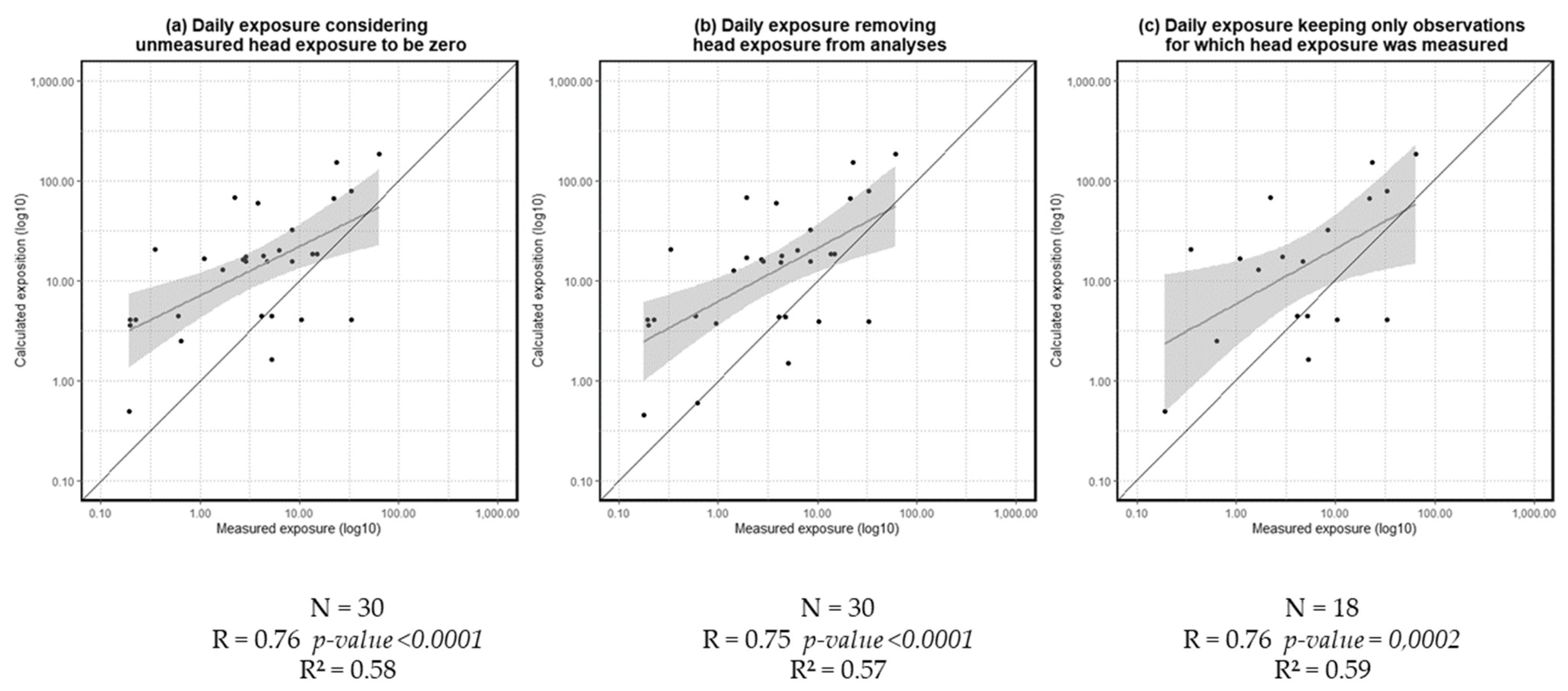
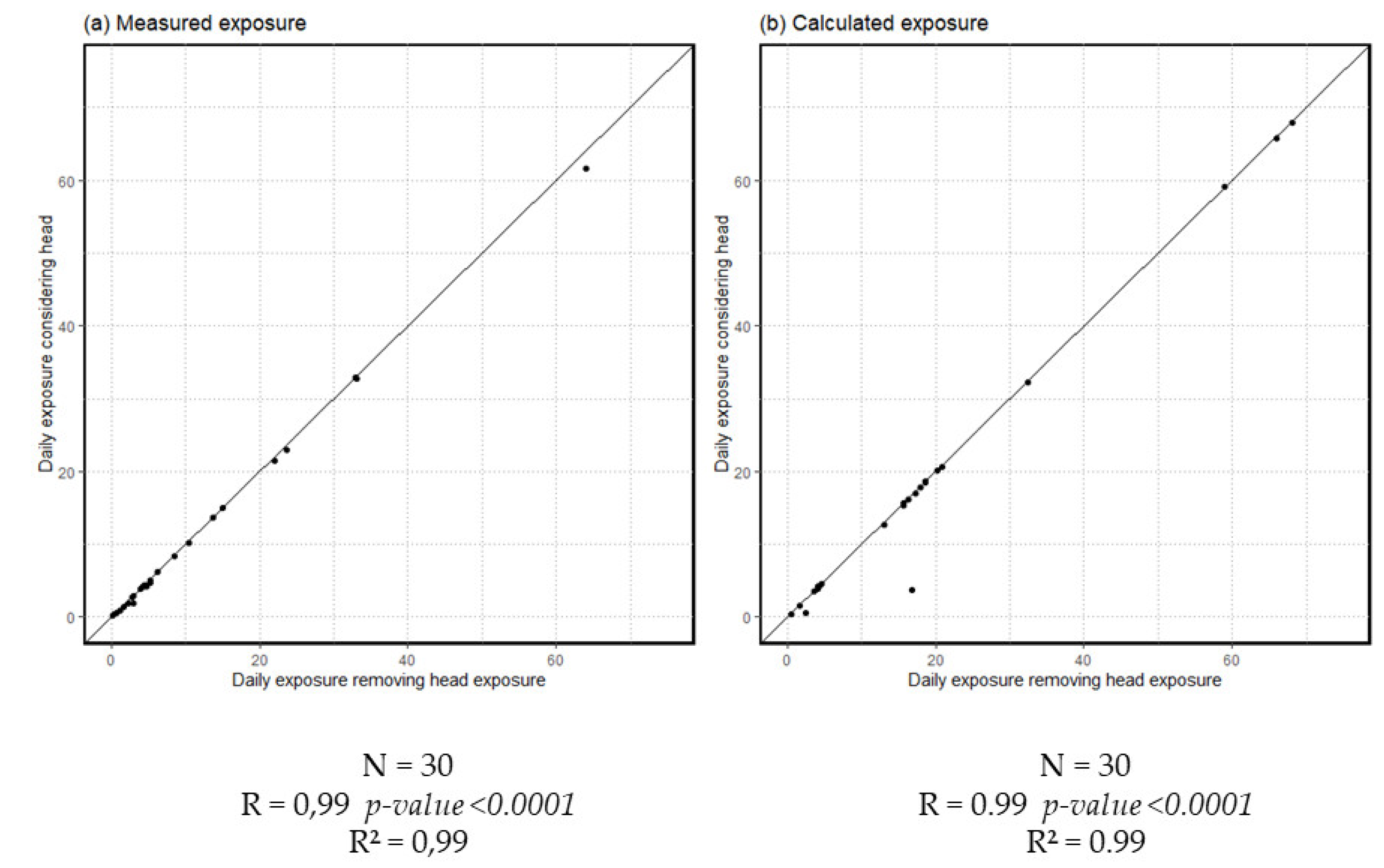
Appendix E
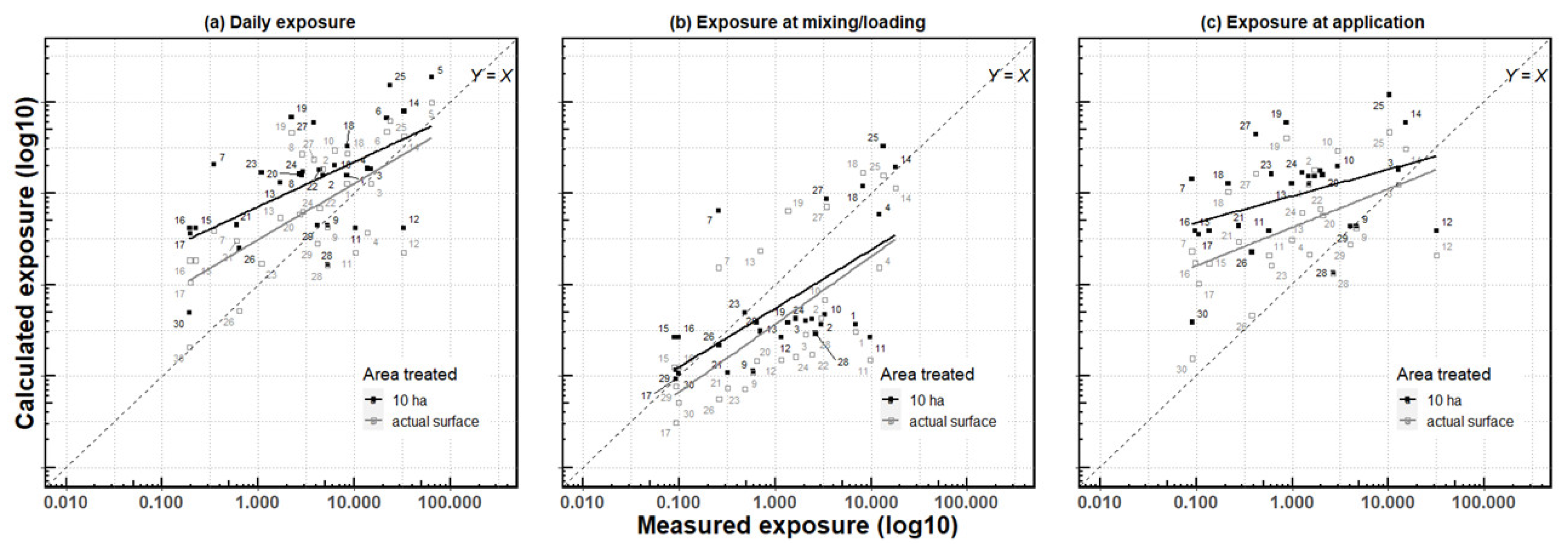
References
- EUROSTAT. Sales of Pesticides in the EU. 2020. Available online: https://ec.europa.eu/eurostat/web/products-eurostat-news/-/DDN-20200603-1 (accessed on 24 September 2020).
- Schinasi, L.; Leon, M.E. Non-Hodgkin Lymphoma and Occupational Exposure to Agricultural Pesticide Chemical Groups and Active Ingredients: A Systematic Review and Meta-Analysis. Int. J. Environ. Res. Public Health 2014, 11, 4449–4527. [Google Scholar] [CrossRef] [PubMed] [Green Version]
- Lewis-Mikhael, A.-M.; Bueno-Cavanillas, A.; Guiron, T.O.; Olmedo-Requena, R.; Delgado-Rodríguez, M.; Jimenez-Moleon, J.J. Occupational exposure to pesticides and prostate cancer: A systematic review and meta-analysis. Occup. Environ. Med. 2016, 73, 134–144. [Google Scholar] [CrossRef] [PubMed]
- Gunnarsson, L.-G.; Bodin, L. Occupational Exposures and Neurodegenerative Diseases—A Systematic Literature Review and Meta-Analyses. Int. J. Environ. Res. Public Health 2019, 16, 337. [Google Scholar] [CrossRef] [PubMed] [Green Version]
- Pourhassan, B.; Meysamie, A.; Alizadeh, S.; Habibian, A.; Beigzadeh, Z. Risk of obstructive pulmonary diseases and occupational exposure to pesticides: A systematic review and meta-analysis. Public Health 2019, 174, 31–41. [Google Scholar] [CrossRef]
- Laurent, C.C.; Baldi, I.; Bernadac, G.; Berthet, A.; Colosio, C.; Garrigou, A.; Grimbuhler, S.; Guichard, L.; Jas, N.; Jouzel, J.; et al. Expositions Professionnelles aux Pesticides en Agriculture; Agence Nationale de Sécurité Sanitaire de l’Alimentation, de l’Environnement et du Travail: Maisons-Alfort, France, 2016. [Google Scholar]
- Van Hemmen, J.J. Predictive exposure modelling for pesticide registration purposes. Ann. Occup. Hyg. 1993, 37, 541–564. [Google Scholar] [CrossRef]
- Van Hemmen, J.J. EUROPOEM, A Predictive Occupational Exposure Database for Registration Purposes of Pesticides. Appl. Occup. Environ. Hyg. 2001, 16, 246–250. [Google Scholar] [CrossRef]
- EFSA. Scientific Opinion on Preparation of a Guidance Document on Pesticide Exposure Assessment for Workers, Operators, Bystanders and Residents. EFSA J. 2010. Available online: https://www.efsa.europa.eu/fr/efsajournal/pub/1501 (accessed on 30 October 2020).
- Richardson, J.; Grosskopf, C.; Hamey, P.Y.; Machera, K.; Martin, S.; Jacobi, L.E.; Tiramani, M. Guidance on the assessment of exposure of operators, workers, residents and bystanders in risk assessment for plant protection products. EFSA J. 2014, 12, 3874. [Google Scholar] [CrossRef]
- Großkopf, C.; Mielke, H.; Westphal, D.; Erdtmann-Vourliotis, M.; Hamey, P.; Bouneb, F.; Rautmann, D.; Stauber, F.; Wicke, H.; Maasfeld, W.; et al. A new model for the predicion of agricultural operator exposure during professional application of plant protection products in outdoor crops. J. Verbrauch. Leb. 2013, 8, 143–153. [Google Scholar] [CrossRef] [Green Version]
- De Cock, J.; Heederik, D.; Boleij, J.S.; Kromhout, H.; Hoek, F.; Wegh, H.; Ny, E.T. Exposure to Captan in Fruit Growing. Am. Ind. Hyg. Assoc. J. 1998, 59, 158–165. [Google Scholar] [CrossRef]
- Lebailly, P.; Bouchart, V.; Baldi, I.; Lecluse, Y.; Heutte, N.; Gislard, A.; Malas, J.-P. Exposure to Pesticides in Open-field Farming in France. In Annals of Work Exposures and Health; Oxford Academic: Oxford, UK, 2009; Available online: https://academic.oup.com/annweh/article/53/1/69/191817 (accessed on 12 June 2020).
- Vitali, M.; Protano, C.; Del Monte, A.; Ensabella, F.; Guidotti, M. Operative Modalities and Exposure to Pesticides During Open Field Treatments Among a Group of Agricultural Subcontractors. Arch. Environ. Contam. Toxicol. 2009, 57, 193–202. [Google Scholar] [CrossRef]
- Baldi, I.; LeBailly, P.; Rondeau, V.; Bouchart, V.; Blanc-Lapierre, A.; Bouvier, G.; Raffin, M.C.; Garrigou, A. Levels and determinants of pesticide exposure in operators involved in treatment of vineyards: Results of the PESTEXPO Study. J. Expo. Sci. Environ. Epidemiol. 2012, 22, 593–600. [Google Scholar] [CrossRef] [PubMed] [Green Version]
- Tsakirakis, A.N.; Kasiotis, K.M.; Charistou, A.N.; Arapaki, N.; Tsatsakis, A.; Tsakalof, A.; Machera, K. Dermal & inhalation exposure of operators during fungicide application in vineyards. Evaluation of coverall performance. Sci. Total Environ. 2014, 470–471, 282–289. [Google Scholar] [CrossRef] [PubMed]
- Aprea, M.C.; Bosi, A.; Manara, M.; Mazzocchi, B.; Pompini, A.; Sormani, F.; Lunghini, L.; Sciarra, G. Assessment of exposure to pesticides during mixing/loading and spraying of tomatoes in the open field. J. Occup. Environ. Hyg. 2016, 13, 476–489. [Google Scholar] [CrossRef] [PubMed]
- European Commission. Report from the Commission to the European Parliament and the Council on Member State National Action Plans and on Progress. In The Implementation of Directive 2009/128/EC on the Sustainable Use of Pesticides; EUR-Lex: Strasbourg, France, 2017; Available online: https://eur-lex.europa.eu/legal-content/EN/TXT/?uri=COM%3A2017%3A587%3AFIN (accessed on 13 December 2021).
- Duporte, G.; Béziat, B.; Bureau, M.; Schawall, X.; Net, J.L.; Barron, E.; Le Menach, K.; Pardon, P.; Lescot, J.-M.; Raffin, M.; et al. Canal Contamination Externe des Agriculteurs et Contamination Environnementales par les Produits Phytosanitaires en Arboriculture: De la Compréhension des Pratiques à la Prévention des Cancers (Projet CANEPA); HAL INRAE: Toulouse, France, 2018; p. 2. [Google Scholar]
- Bureau, M.; Béziat, B.; Duporté, G.; Bouchart, V.; Lecluse, Y.; Barron, E.; Garrigou, A.; Dévier, M.-H.; Budzinski, H.; Lebailly, P.; et al. Pesticide exposure of workers in apple growing in France. Int. Arch. Occup. Environ. Health, 2021; Epub ahead of print. [Google Scholar] [CrossRef]
- Lee, J.; Kim, E.; Shin, Y.; Lee, J.; Lee, J.; Moon, J.-K.; Choi, H.; Maasfeld, W.; Kim, J.-H. Whole body dosimetry and risk assessment of agricultural operator exposure to the fungicide kresoxim-methyl in apple orchards. Ecotoxicol. Environ. Saf. 2018, 155, 94–100. [Google Scholar] [CrossRef] [PubMed]
- Moon, J.-K.; Park, S.; Kim, E.; Lee, H.; Kim, J.-H. Risk Assessment of the Exposure of Insecticide Operators to Fenvalerate during Treatment in Apple Orchards. J. Agric. Food Chem. 2013, 61, 307–311. [Google Scholar] [CrossRef]
- Yeung, P.; Cantrell, P.; Murdoch, C.; Rogers, A.; Apthorpe, L.; Vickers, C.; Conaty, G. Exposure of Air Blast Applicators to Ethyl Parathion and Methyl Parathion in Orchards: A Comparison of Australian Conditions to Overseas Predictive Exposure Models. Appl. Occup. Environ. Hyg. 1998, 13, 242–251. [Google Scholar] [CrossRef]
- Soutar, A.; Semple, S.; Aitken, R.J.; Robertson, A. Use of patches and whole body sampling for the assessment of dermal exposure. Ann. Occup. Hyg. 2000, 44, 511–518. [Google Scholar] [CrossRef] [Green Version]
- OECD. Guidance Document for the Conduct of Studies of Occupational Exposure to Pesticides during Agricultural Application; OECD: Paris, France, 2002. [Google Scholar] [CrossRef]
- Kim, E.; Moon, J.-K.; Choi, H.; Kim, J.-H. Probabilistic Exposure Assessment for Applicators during Treatment of the Fungicide Kresoxim-methyl on an Apple Orchard by a Speed Sprayer. J. Agric. Food Chem. 2015, 63, 10366–10371. [Google Scholar] [CrossRef]
- Zhao, M.-A.; Yu, A.; Zhu, Y.-Z.; Kim, J.-H. Potential Dermal Exposure to Flonicamid and Risk Assessment of Applicators During Treatment in Apple Orchards. J. Occup. Environ. Hyg. 2015, 12, D147–D152. [Google Scholar] [CrossRef]
- Hines, C.J.; Deddens, J.A.; Coble, J.; Kamel, F.; Alavanja, M.C.R. Determinants of Captan Air and Dermal Exposures among Orchard Pesticide Applicators in the Agricultural Health Study. Ann. Occup. Hyg. 2011, 55, 620–633. [Google Scholar] [CrossRef] [PubMed] [Green Version]
- Hines, C.J.; Deddens, J.A.; Jaycox, L.B.; Andrews, R.N.; Striley, C.A.F.; Alavanja, M.C.R. Captan Exposure and Evaluation of a Pesticide Exposure Algorithm among Orchard Pesticide Applicators in the Agricultural Health Study. Ann. Occup. Hyg. 2008, 52, 153–166. [Google Scholar] [CrossRef] [PubMed]
- De Cock, J.; Heederik, D.; Boleij, J.S.; Kromhout, H.; Hoek, F.; Wegh, H.; Ny, E.T. Determinants of Exposure to Captan in Fruit Growing. Am. Ind. Hyg. Assoc. J. 1998, 59, 166–172. [Google Scholar] [CrossRef] [PubMed]
- French Ministry of Agriculture. Enquête sur la Structure des Exploitations Agricoles. En 2016, des Exploitations Moins Nombreuses Mais Plus Grandes; French Ministry of Agriculture: Paris, France, 2018.
- Kasiotis, K.M.; Spaan, S.; Tsakirakis, A.N.; Franken, R.; Chartzala, I.; Anastasiadou, P.; Machera, K.; Rother, D.; Roitzsch, M.; Poppek, U.; et al. Comparison of Measurement Methods for Dermal Exposure to Hazardous Chemicals at the Workplace: The SysDEA Project. Ann. Work Expo. Health 2020, 64, 55–70. [Google Scholar] [CrossRef]
- Wong, H.L.; Garthwaite, D.G.; Ramwell, C.T.; Brown, C.D. Assessment of exposure of professional agricultural operators to pesticides. Sci. Total Environ. 2018, 619-620, 874–882. [Google Scholar] [CrossRef] [Green Version]
- Boissonnot, R. Risques sanitaires et perception chez les agriculteurs utilisateurs de produits phytopharmaceutiques. Ph.D. Thesis, Conservatoire National des Arts et Metiers-CNAM, Paris, France, 2014. [Google Scholar]
- Damalas, C.A.; Eleftherohorinos, I.G. Pesticide Exposure, Safety Issues, and Risk Assessment Indicators. Int. J. Environ. Res. Public Health 2011, 8, 1402–1419. [Google Scholar] [CrossRef]
- Garrigou, A.; Laurent, C.; Berthet, A.; Colosio, C.; Jas, N.; Daubas-Letourneux, V.; Filho, J.-M.J.; Jouzel, J.-N.; Samuel, O.; Baldi, I.; et al. Critical review of the role of PPE in the prevention of risks related to agricultural pesticide use. Saf. Sci. 2020, 123, 104527. [Google Scholar] [CrossRef]
- Keifer, M.C. Effectiveness of interventions in reducing pesticide overexposure and poisonings. Am. J. Prev. Med. 2000, 18, 80–89. [Google Scholar] [CrossRef]
- Hines, C.J.; Deddens, J.A.; Coble, J.; Alavanja, M.C.R. Fungicide application practices and personal protective equipment use among orchard farmers in the agricultural health study. J. Agric. Saf. Health 2007, 13, 205–223. [Google Scholar] [CrossRef]
- Sanvido, O.; Schmid, K.; Fitzgerald, R.E.; Roth, N.; Wilks, M.F.; Bormann, P.; Hopf, N.B. A quantitative risk assessment for skin sensitizing plant protection products: Linking derived No-Effect levels (DNELs) with agricultural exposure models. Regul. Toxicol. Pharmacol. 2018, 98, 171–183. [Google Scholar] [CrossRef] [Green Version]
- Machado, S.C.; Martins, I. Risk assessment of occupational pesticide exposure: Use of endpoints and surrogates. Regul. Toxicol. Pharmacol. 2018, 98, 276–283. [Google Scholar] [CrossRef] [PubMed]
- Garzia, N.A.; Spinelli, J.J.; Gotay, C.C.; Teschke, K. Literature review: Dermal monitoring data for pesticide exposure assessment of farm workers. J. Agromed. 2018, 23, 187–214. Available online: https://www.tandfonline.com/doi/abs/10.1080/1059924X.2018.1448734 (accessed on 23 February 2021). [CrossRef] [PubMed]
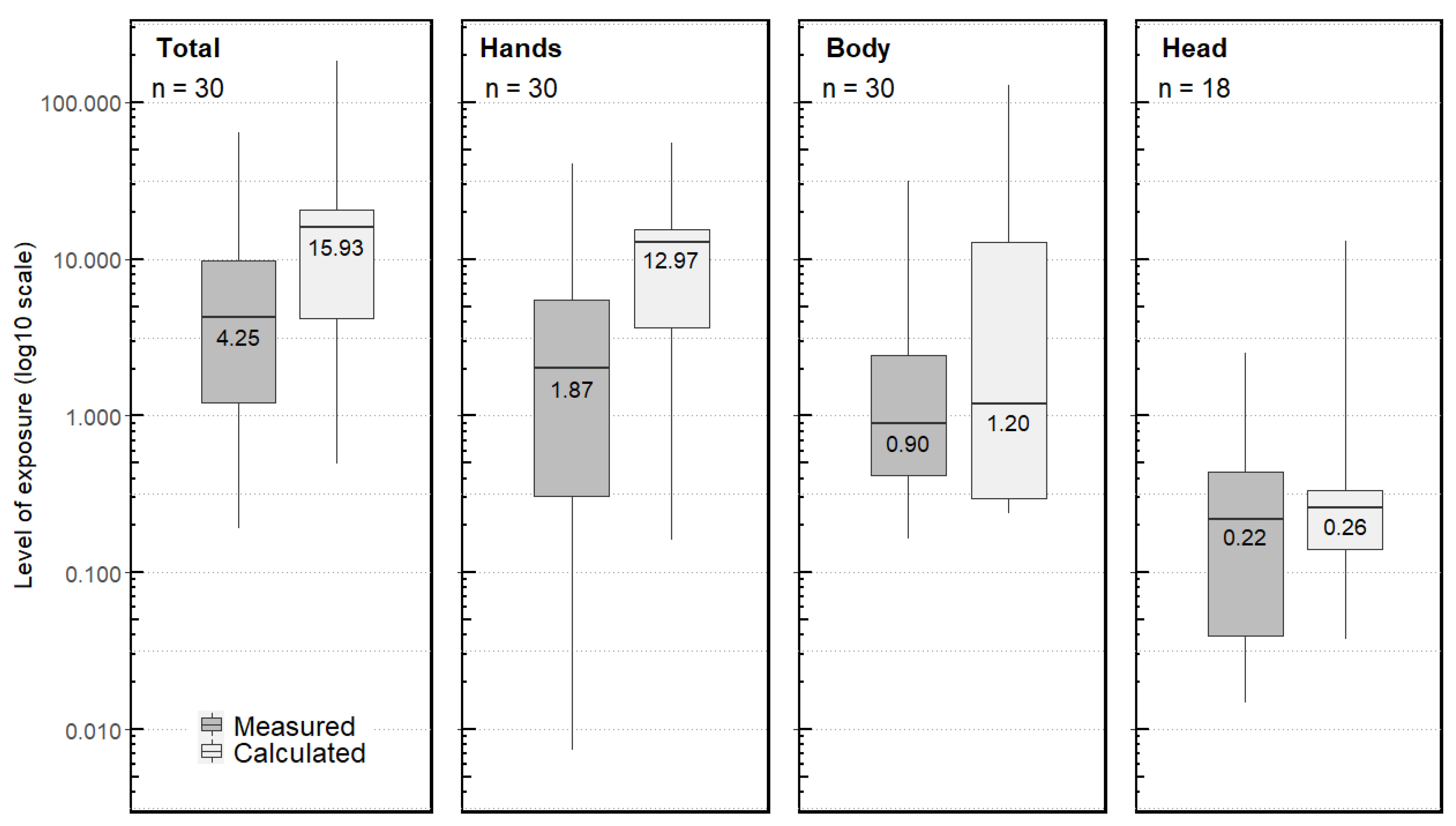
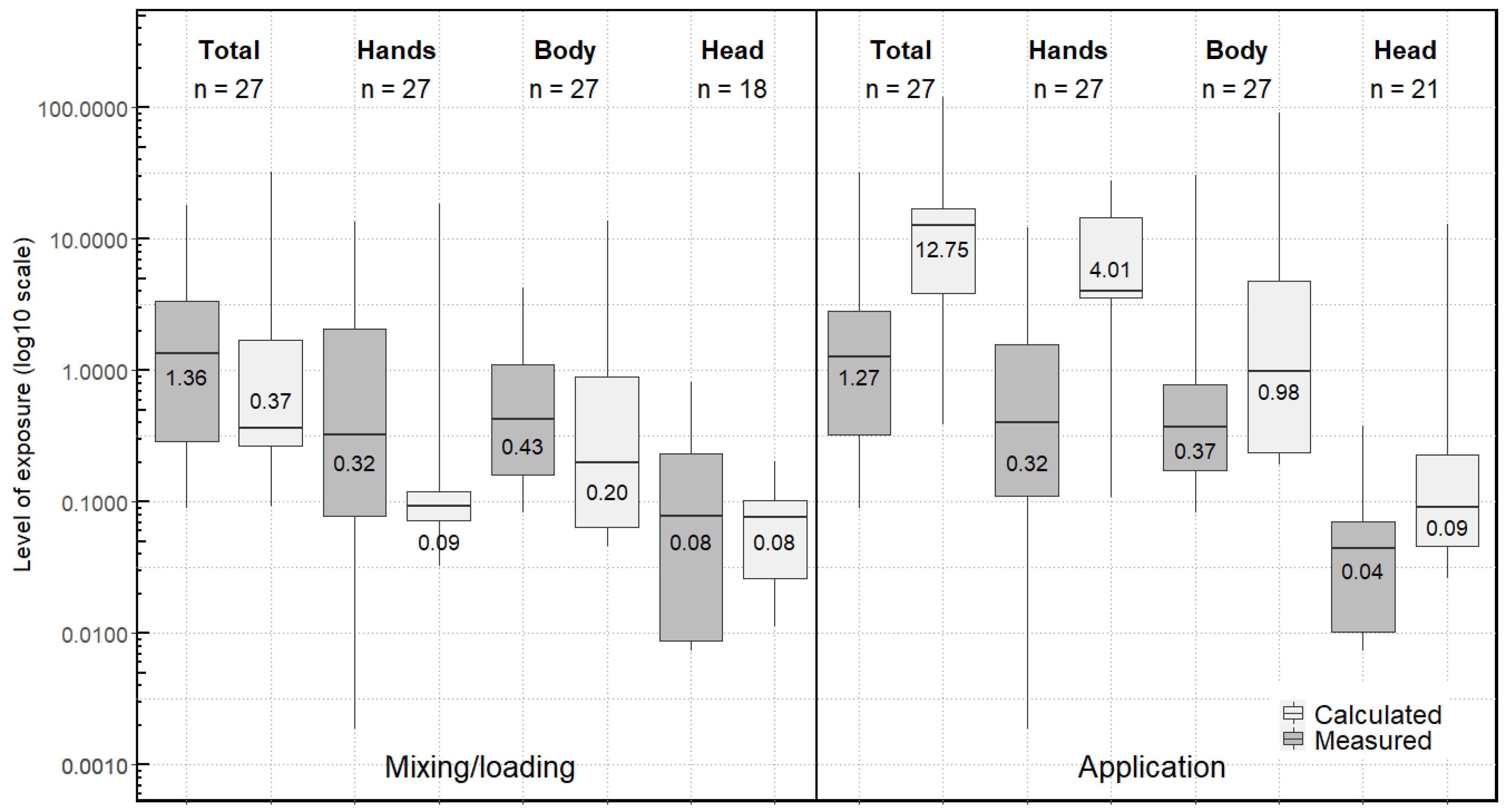
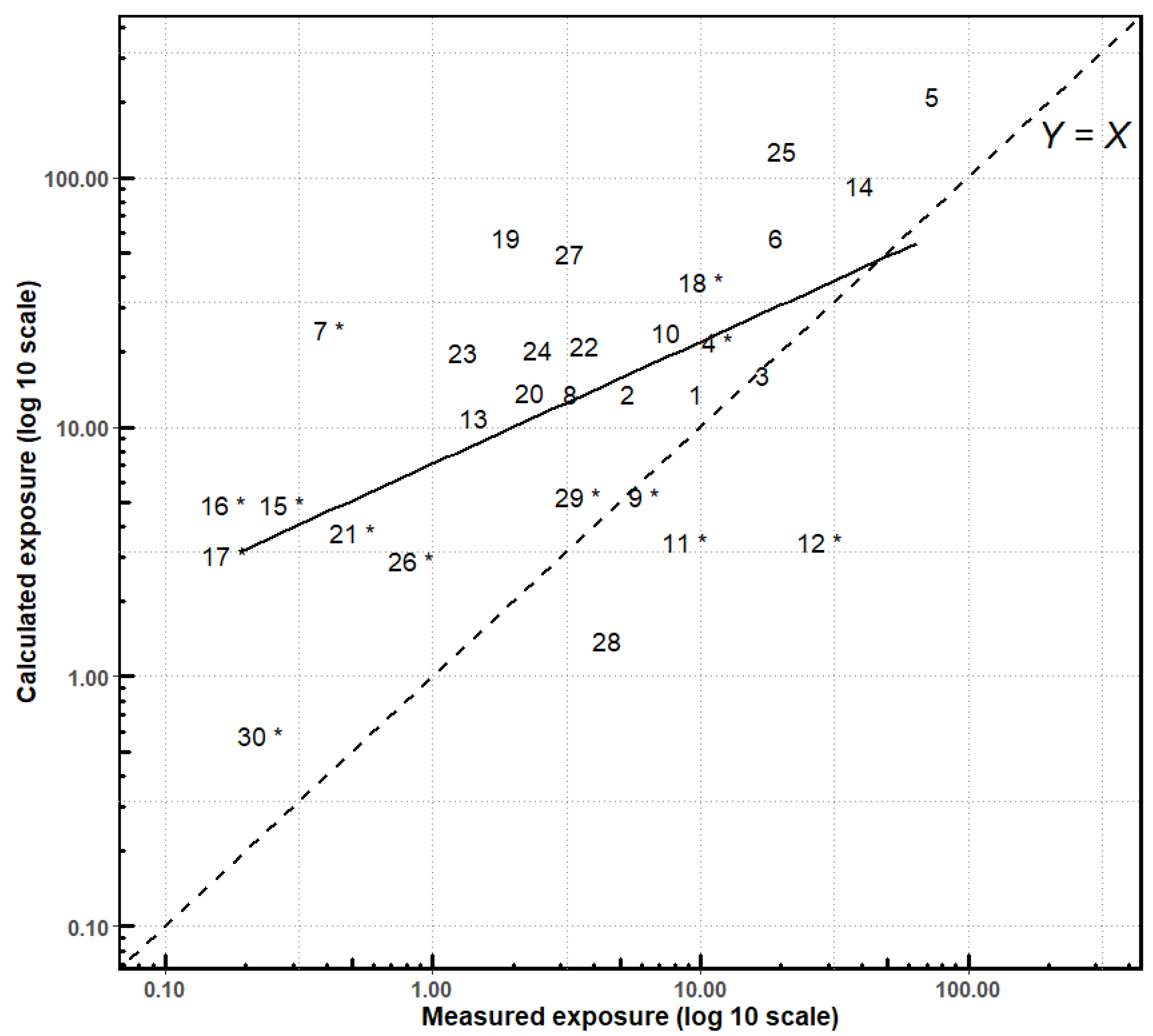
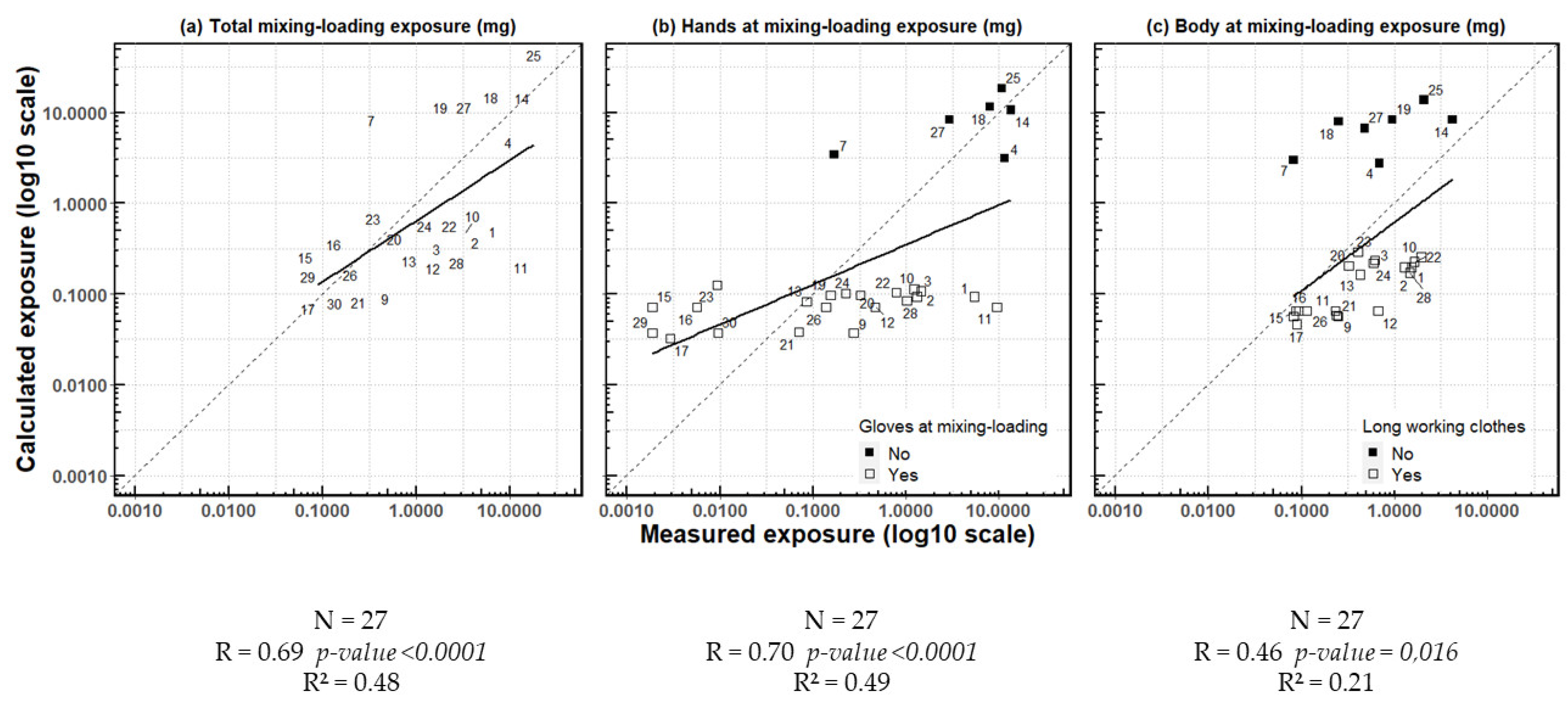
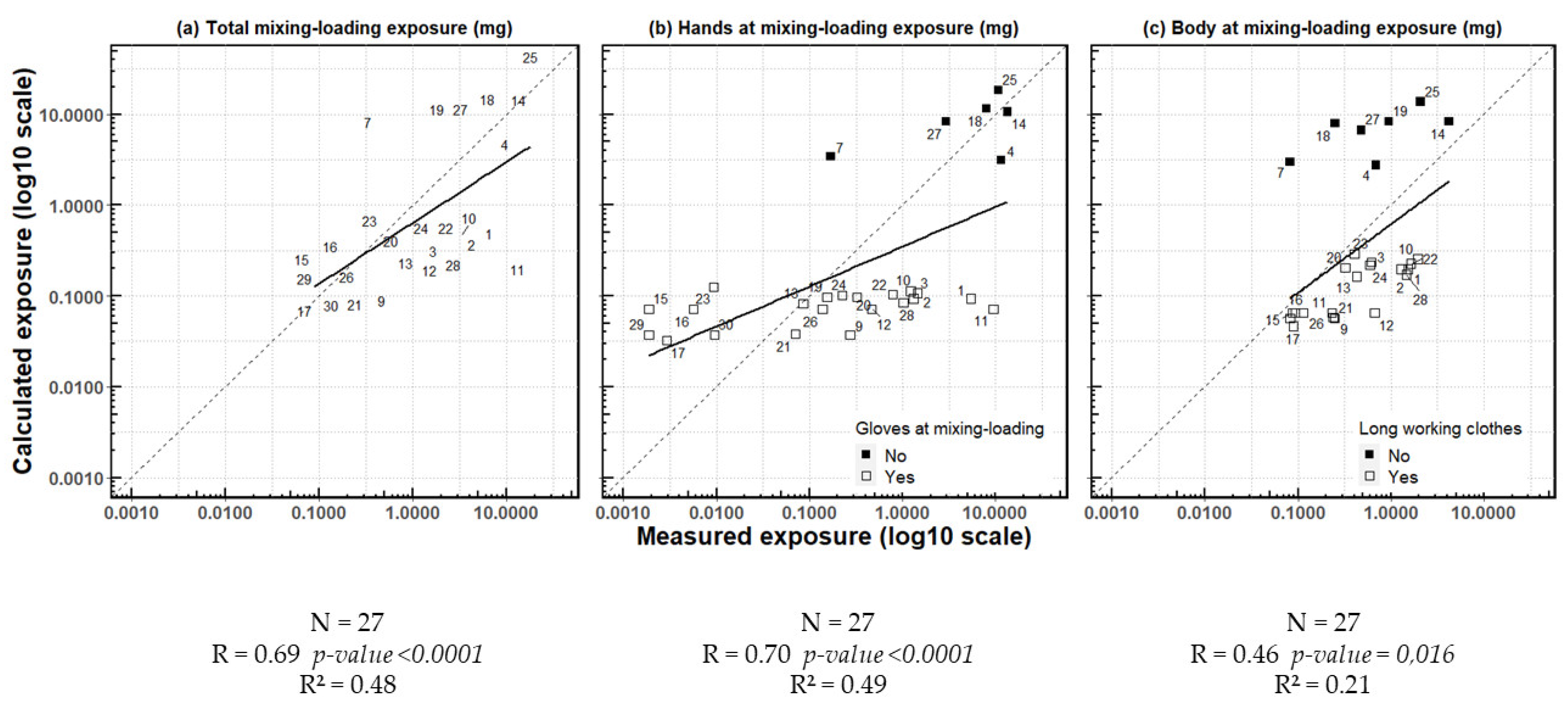
| N | Min | 25th Centile | Median | 75th Centile | Max | |||
|---|---|---|---|---|---|---|---|---|
| Daily area treated (ha) | In CANEPA | 30 | 1.01 | 3.26 | 5 | 6.9 | 18.3 | |
| In the AOEM | 30 | 10 | ||||||
| Rate of active substance applied per ha (kg/ha) | Captan WG | 17 | 1.11 | 1.44 | 1.52 | 1.76 | 3.84 | |
| Dithianon WG | 7 | 0.28 | 0.33 | 0.35 | 0.35 | 0.36 | ||
| Dithianon SC 1 | 6 | 0.31 | ||||||
| Amount of active substance applied in a day (kg/day) | Captan WG | Applied in CANEPA | 17 | 2.24 | 5.15 | 10.32 | 12 | 29.6 |
| Calculated by AOEM | 11.1 | 14.4 | 15.2 | 17.6 | 38.4 | |||
| Dithianon WG | Applied in CANEPA | 7 | 0.49 | 0.61 | 1.4 | 2.21 | 3.36 | |
| Calculated by AOEM | 2.8 | 3.3 | 3.5 | 3.5 | 3.6 | |||
| Dithianon SC 2 | Applied in CANEPA | 6 | 0.63 | 1.25 | 1.41 | 1.56 | 2.5 | |
| Calculated by AOEM | 3.1 | |||||||
Publisher’s Note: MDPI stays neutral with regard to jurisdictional claims in published maps and institutional affiliations. |
© 2022 by the authors. Licensee MDPI, Basel, Switzerland. This article is an open access article distributed under the terms and conditions of the Creative Commons Attribution (CC BY) license (https://creativecommons.org/licenses/by/4.0/).
Share and Cite
Bresson, M.; Bureau, M.; Le Goff, J.; Lecluse, Y.; Robelot, E.; Delamare, J.; Baldi, I.; Lebailly, P. Pesticide Exposure in Fruit-Growers: Comparing Levels and Determinants Assessed under Usual Conditions of Work (CANEPA Study) with Those Predicted by Registration Process (Agricultural Operator Exposure Model). Int. J. Environ. Res. Public Health 2022, 19, 4611. https://doi.org/10.3390/ijerph19084611
Bresson M, Bureau M, Le Goff J, Lecluse Y, Robelot E, Delamare J, Baldi I, Lebailly P. Pesticide Exposure in Fruit-Growers: Comparing Levels and Determinants Assessed under Usual Conditions of Work (CANEPA Study) with Those Predicted by Registration Process (Agricultural Operator Exposure Model). International Journal of Environmental Research and Public Health. 2022; 19(8):4611. https://doi.org/10.3390/ijerph19084611
Chicago/Turabian StyleBresson, Morgane, Mathilde Bureau, Jérémie Le Goff, Yannick Lecluse, Elsa Robelot, Justine Delamare, Isabelle Baldi, and Pierre Lebailly. 2022. "Pesticide Exposure in Fruit-Growers: Comparing Levels and Determinants Assessed under Usual Conditions of Work (CANEPA Study) with Those Predicted by Registration Process (Agricultural Operator Exposure Model)" International Journal of Environmental Research and Public Health 19, no. 8: 4611. https://doi.org/10.3390/ijerph19084611
APA StyleBresson, M., Bureau, M., Le Goff, J., Lecluse, Y., Robelot, E., Delamare, J., Baldi, I., & Lebailly, P. (2022). Pesticide Exposure in Fruit-Growers: Comparing Levels and Determinants Assessed under Usual Conditions of Work (CANEPA Study) with Those Predicted by Registration Process (Agricultural Operator Exposure Model). International Journal of Environmental Research and Public Health, 19(8), 4611. https://doi.org/10.3390/ijerph19084611






